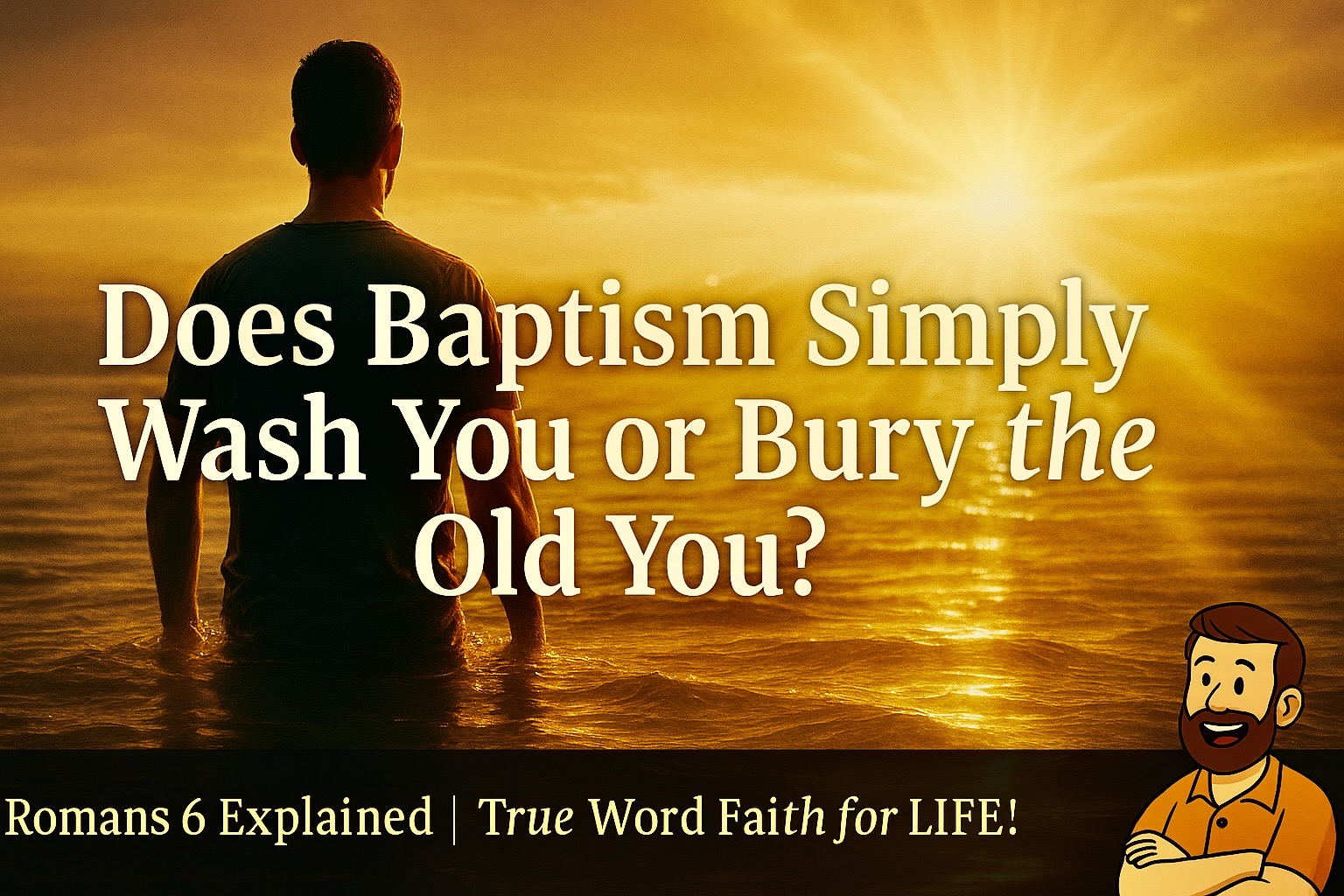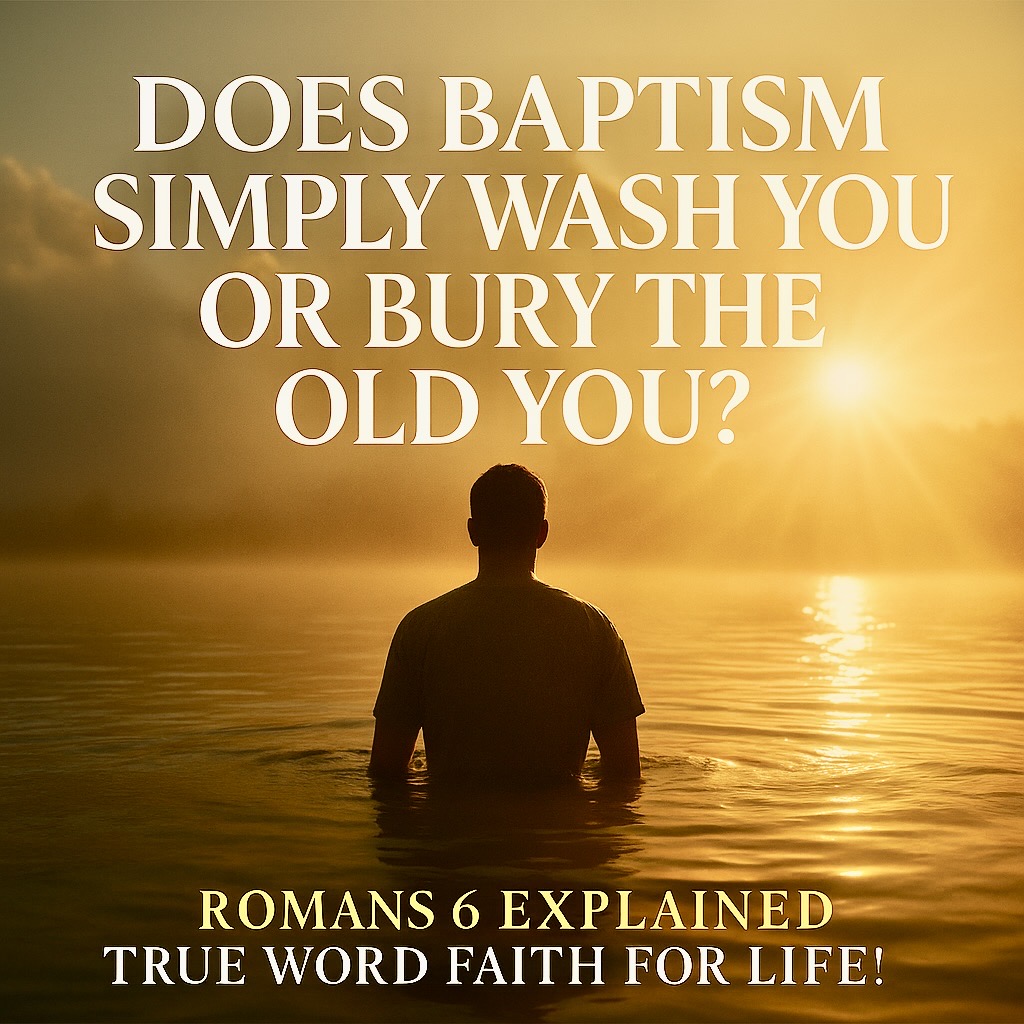Does Baptism Simply Wash You; or Bury the Old You?

Does Baptism Simply Wash You—or Bury the Old You?
Series: Romans — Covenant, Faithfulness, and the Grafted-In Life
What if baptism isn’t just a ceremony of water but a declaration of death?
What if it’s not about joining a church, but leaving Adam’s humanity behind and entering the life of Messiah?
Romans 6 pulls back the curtain to reveal the breathtaking truth: baptism is not symbolic; it is covenantal.
It’s the place where grace becomes loyalty, where sin’s reign ends and new life begins.
⸻
Scripture Reading — Romans 6:1-11 (LEB)
“What then shall we say? Should we continue in sin so that grace may increase? By no means! How can we who died to sin still live in it? Or do you not know that as many as were baptized into Christ Jesus were baptized into His death? Therefore we have been buried with Him through baptism into death, in order that, just as Christ was raised from the dead through the glory of the Father, so we also may live a new way of life. For if we have become identified with Him in the likeness of His death, we will certainly also be identified with Him in the likeness of His resurrection. We know that our old man was crucified with Him so that the body of sin could be done away with, that we should no longer be enslaved to sin. For the one who has died has been set free from sin. Now if we died with Christ, we believe that we will also live with Him, knowing that Christ, once raised from the dead, no longer dies; death no longer has mastery over Him. For the death He died, He died to sin once for all, but the life He lives, He lives to God. So you also consider yourselves dead to sin, but alive to God in Christ Jesus.”
Yevarekh Elohim et k’ri’at d’varo; May God bless the reading of His Word.
⸻
I. From Grace to Loyalty
Paul begins Romans 6 with a shocking question: “Should we continue in sin so that grace may increase?”
His answer: Absolutely not!
Grace isn’t permission to sin; it’s power to live faithfully. Dr. Skip Moen writes,
“Grace without obedience isn’t grace at all; it’s distortion.”
The Hebrew concept of chen (khane); grace; means divine favor that enables covenant obedience.
Grace trains the heart to love what God loves and hate what destroys life.
⸻
II. Baptized into His Death
Paul continues, “All of us who have been baptized into Messiah Yeshua were baptized into His death.”
Baptism is the covenant burial of Adam’s humanity. The person you were before Messiah is drowned.
When you rise from the water, it’s not a mere ritual; it’s resurrection.
In Hebrew thought, to be “immersed” (tabal) was to be completely enveloped; to leave one realm and emerge into another.
In Messiah, you are leaving exile and entering covenant life.
⸻
III. United with Him
“If we have been united with Him in a death like His, we will certainly be united with Him in a resurrection like His.”
The Greek term sumphytos means “grown together,” like two roots entwined beneath the soil.
You are now organically joined to Messiah’s death and His resurrection.
Your old self; the anthropos palaios; was crucified.
You no longer owe sin any allegiance.
Taco Tony leaned across the table one day and said,
“Doc, are you saying baptism isn’t just about getting wet but about getting buried?” Exactly, Tony. And when you come up, you’re not just cleaner; you’re different.
⸻
IV. Alive to God, Dead to Sin
Paul urges, “Consider yourselves dead to sin and alive to God in Messiah Yeshua.”
That phrase “consider yourselves” means to reckon, to account as true.
He’s not asking for emotion; He’s calling for conviction.
Sin may still knock, but it no longer holds the deed to your house.
You are under grace, not under law as condemnation.
Grace doesn’t erase the Torah; it empowers us to walk in it.
Through the Spirit, the law once carved on stone is now engraved on the heart.
⸻
V. Slaves of Righteousness
Once, you were enslaved to sin. Now, you serve righteousness.
Freedom in Scripture isn’t autonomy—it’s covenant service to the rightful King.
Dr. Michael Heiser observed,
“True freedom isn’t doing whatever you want; it’s loyalty to the God who made you.”
When you serve righteousness, you don’t lose freedom—you find purpose.
⸻
VI. Eternal Covenant Destiny
Paul concludes:
“Now that you have been set free from sin and have become slaves of God, the fruit you get leads to sanctification, and its end, eternal life. For the wages of sin is death, but the free gift of God is eternal life in Messiah Yeshua our Lord.”
Two masters. Two destinies.
Sin pays its workers in death. God gifts His children with life.
Baptism isn’t merely about where you’ll spend eternity. It’s about Who you serve today.
⸻
💡 Challenge and a Choice
Challenge: Are you living like someone who has died to sin, or are you still letting sin sit on the throne?
Choice: Will you remain bound to Adam’s rebellion—or will you live as one resurrected into Messiah’s covenant life?
⸻
🙏 Prayer of Salvation
Heavenly Father, I come to You today with an open and humble heart.
I know that I have sinned and fallen short of Your glory, and I’m asking for Your forgiveness.
Right now, I turn away from my sins and turn fully toward You.
I believe that Jesus, Your Son, is the promised Messiah—that He died for my sins, was buried, and rose again on the third day just as the Bible says.
Today I call on Your holy Name. Please forgive me, cleanse me, and make me new.
Fill me with Your Holy Spirit and write Your truth on my heart.
From this day forward, I choose to follow Jesus as my Lord, my Redeemer, and my King.
Thank You for loving me, for saving me, and for making me part of Your family forever.
In the name of Jesus Christ, the King of Kings, I pray. Amen.
➡ I am so excited for you because this decision is the most important of your existence!
Contact me through this link: Connect Directly with Dr. Shawn! and I will personally help you along the way!”
⸻
Before we close today, I want to ask you for one simple favor.
If this episode stirred your heart, if it helped you see God’s Word more clearly, or if it challenged you in your walk of faith; please don’t keep it to yourself!
Think of one person who needs encouragement, who needs truth, who needs hope. Surely you know at least ONE person! Send this episode to them right now. Be that friend who shares truth in a world filled with confusion.
And if you’re on social media that makes it easy! Post the link to this episode and let others know what blessed you? You never know who might be doom scrolling today and find exactly what they need through your share.
Your share could be the very tool God uses to reach someone with His Word.
If you do NOT want to share this, please email me at smgreener@gmail.com or and help me understand why not. Or, click this link: Contact me Confidentialy
No judgment; I just want to learn how to reach people more effectively.
⸻
Remember…
Baptism is not just washing, it is covenant burial.
Study Guide
Does Baptism Simply Wash You; or Bury the Old You?
Series: Romans: Covenant, Faithfulness, and the Grafted-In Life
⸻
Summary
Romans 6:1–11 is one of the most powerful theological hinge points in Paul’s letter. It connects the covenantal logic of salvation with the lived experience of discipleship. The Apostle Paul dismantles the notion that grace gives license to sin. Instead, he reveals that grace brings about a radical transformation; a death and resurrection in the life of every believer.
Baptism, in this light, is not a symbolic washing but a covenant burial. Through immersion, the believer publicly declares death to the old humanity; Adam’s fallen nature; and resurrection into the new humanity in Messiah Yeshua. This act seals one’s participation in Messiah’s death and resurrection.
Paul’s argument follows the Hebrew pattern of covenant renewal. Just as Israel was “baptized into Moses” through the sea (1 Corinthians 10:2), believers are baptized into Messiah through His death and resurrection. In both cases, the crossing of water marks a transition; from slavery to freedom, from Egypt to covenant life, from sin’s dominion to righteousness.
Baptism, therefore, is not merely ritual. It is covenant identity. It signifies allegiance to the King, not membership in an institution. It declares that the believer’s old self (anthropos palaios) has been crucified, and a new creation has emerged through resurrection power (2 Corinthians 5:17).
Through this transformation, believers no longer serve sin as master but righteousness as covenant loyalty. As Dr. Michael Heiser observed, “True freedom isn’t doing whatever you want; it’s loyalty to the God who made you.” This truth defines Paul’s understanding of covenant faithfulness—faith that works through loyal obedience.
⸻
Key Hebrew and Greek Terms
1.Χάρις (Charis) — Grace
In Hebraic thought, grace (chen, חֵן) is divine favor that empowers faithfulness. It is not passive pardon but active enablement. Grace trains us to obey, not to excuse disobedience (Titus 2:11–12).
2.טָבַל (Tabal) — Immerse
This Hebrew verb means “to dip, to immerse, to plunge.” It appears in ritual purification contexts (Leviticus 14:6, 51). Immersion symbolized transition from defilement to holiness, from exile to belonging.
3.Βαπτίζω (Baptizō) — To Baptize / Immerse
The Greek term aligns closely with tabal, emphasizing total submersion. It carries covenant significance, marking identity and allegiance to a new reality (cf. Acts 2:38, Galatians 3:27).
4.Σύμφυτος (Sumphytos) — United / Grown Together
This word describes organic unity; like two roots entwined. Believers become grafted into Messiah’s life, death, and resurrection (Romans 6:5). This imagery echoes the grafting metaphor of Romans 11.
5.Ἀνθρωπος Παλαιός (Anthropos Palaios) — Old Man / Old Humanity
This phrase represents the Adamic nature inherited through the Fall (Romans 5:12). In baptism, that nature is crucified with Messiah, breaking sin’s dominion.
6.Δικαιοσύνη (Dikaiosynē) — Righteousness
Not moral perfection but covenant faithfulness; right relationship expressed through loyal obedience.
7.Χάρις καὶ Νόμος (Charis kai Nomos) — Grace and Torah
In Hebraic context, grace and law are not opposites. Grace empowers the fulfillment of Torah by the Spirit (Jeremiah 31:33; Romans 8:4).
⸻
Exegetical Context
Author: Sha’ul (Paul), a Jewish rabbi and apostle to the Gentiles.
Audience: Mixed congregation in Rome; Jewish and Gentile believers navigating covenant identity.
Historical Setting: Written around 57 CE from Corinth, Romans addresses how Gentiles are grafted into Israel’s covenant without abandoning God’s Torah or His people.
Purpose of Chapter 6: To clarify that grace is not license but liberation; from sin’s tyranny to covenant loyalty.
Paul’s argument in Romans 6 relies on the Deuteronomy 30 covenant pattern: life or death, blessing or curse, allegiance or rebellion. Baptism marks the believer’s choice to enter life by dying with Messiah.
⸻
Covenantal Theology of Baptism
In the Ancient Near Eastern (ANE) world, water often symbolized chaos and death (Genesis 1:2; Psalm 74:13–14). When God’s Spirit hovered over the waters, He brought order and creation out of chaos. Similarly, baptism reenacts this creation motif; God brings new life from the waters of death.
Just as Noah emerged from the flood, and Israel passed through the Red Sea, the believer rises from baptismal waters as a new creation. Each event marks covenant renewal through divine deliverance.
Paul’s use of burial language evokes Genesis 3 and Romans 5. The first Adam brought death; the last Adam brings life (1 Corinthians 15:45). Baptism unites believers with Messiah’s covenant obedience and resurrection victory.
⸻
Discussion Questions
1. How does Paul’s view of grace differ from the modern Western concept of forgiveness without transformation?
2. In what ways does baptism signify more than cleansing? How does it represent death and resurrection?
3. What does it mean to “reckon yourself dead to sin” in everyday life? How can this change the way you handle temptation?
4. How do the Hebraic ideas of chen (grace) and tabal (immersion) deepen our understanding of covenant faithfulness?
5. How might baptism as covenant burial challenge modern church traditions that treat it as symbolic or optional?
6. What parallels do you see between Israel’s deliverance through the Red Sea and the believer’s deliverance through baptism?
7. How can this teaching on baptism influence your approach to discipleship and sanctification?
⸻
Practical Application
1. Daily Reckoning: Begin each day affirming: “I am dead to sin and alive to God in Messiah Yeshua.” Speak it as truth, not feeling.
2. Covenant Mindset: Remember that baptism was your enlistment into God’s kingdom. You no longer serve sin; you serve righteousness.
3. Community Witness: Share your baptism story as testimony of transformation, not tradition. It’s a public declaration of covenant loyalty.
4. Spiritual Accountability: Surround yourself with those who remind you who you are in Messiah. True community reinforces covenant identity.
5. Ongoing Immersion: In Hebrew idiom, to be immersed in something means to live fully within it. Be “immersed” daily in God’s Word, prayer, and covenant obedience.
⸻
Key Takeaways
• Baptism is covenantal, not ceremonial.
• Grace does not erase obedience; it empowers it.
• The believer’s old self is buried, not merely cleaned.
• To be united with Messiah is to share His death and resurrection.
• Freedom in the Kingdom means service to righteousness.
• Eternal life begins now, as covenant loyalty is lived daily.
⸻
Turabian Footnotes
1. Michael Heiser, The Unseen Realm: Recovering the Supernatural Worldview of the Bible (Bellingham, WA: Lexham Press, 2015), 271.
2. Skip Moen, Spiritual Restoration: Reclaiming the Foundations of Faith (Jacksonville, FL: At God’s Table Publishing, 2019), 88.
3. Jeffrey Tigay, Deuteronomy: The JPS Torah Commentary (Philadelphia: Jewish Publication Society, 1996), 284–286.
4. N. T. Wright, Paul and the Faithfulness of God (Minneapolis: Fortress Press, 2013), 1035–1037.
5. David Stern, Complete Jewish Study Bible (Peabody, MA: Hendrickson Publishers, 2016), notes on Romans 6:3–5.
6. Craig Keener, Romans: A New Covenant Commentary (Eugene, OR: Cascade Books, 2009), 92–95.
7. Michael Fishbane, Biblical Interpretation in Ancient Israel (Oxford: Clarendon Press, 1985), 355–357.
8. John Walton, Ancient Near Eastern Thought and the Old Testament (Grand Rapids: Baker Academic, 2006), 243–244.
⸻
Bibliography
• Fishbane, Michael. Biblical Interpretation in Ancient Israel. Oxford: Clarendon Press, 1985.
• Heiser, Michael S. The Unseen Realm: Recovering the Supernatural Worldview of the Bible. Bellingham, WA: Lexham Press, 2015.
• Keener, Craig S. Romans: A New Covenant Commentary. Eugene, OR: Cascade Books, 2009.
• Moen, Skip. Spiritual Restoration: Reclaiming the Foundations of Faith. Jacksonville, FL: At God’s Table Publishing, 2019.
• Stern, David H., ed. Complete Jewish Study Bible. Peabody, MA: Hendrickson Publishers, 2016.
• Tigay, Jeffrey. Deuteronomy: The JPS Torah Commentary. Philadelphia: Jewish Publication Society, 1996.
• Walton, John H. Ancient Near Eastern Thought and the Old Testament. Grand Rapids: Baker Academic, 2006.
• Wright, N. T. Paul and the Faithfulness of God. Minneapolis: Fortress Press, 2013.
⸻
Shalom b’Shem Yeshua
© 2025 Dr. Shawn M. Greener. All Rights Reserved.
True Word, Faith for LIFE!
Romans 6, Baptism explained, True Word Faith for LIFE, Dr Shawn M Greener, covenant faithfulness, baptism in Messiah, Romans 6 Bible study, Messianic faith, Ancient Near Eastern context, Hebraic worldview, grace and obedience, righteousness, new life in Christ, baptized into death, resurrection life, follower of the Way, Bible teaching, covenant discipleship, grace reigns, Yeshua HaMashiach, Dr Greener teaching, Biblical theology, True Word Faith, salvation, repentance, dying to self, living for Christ, sanctification
#TrueWordFaithForLife #Romans6 #Baptism #CovenantLife #FollowerOfTheWay #YeshuaHaMashiach #GraceAndTruth #BibleStudy #FaithForLife #CovenantFaithfulness





